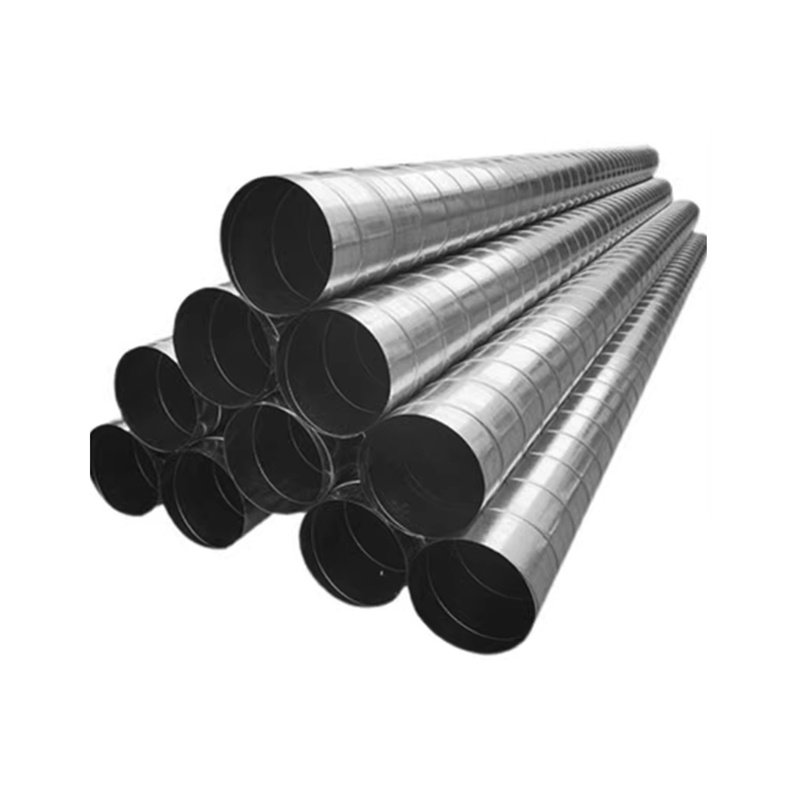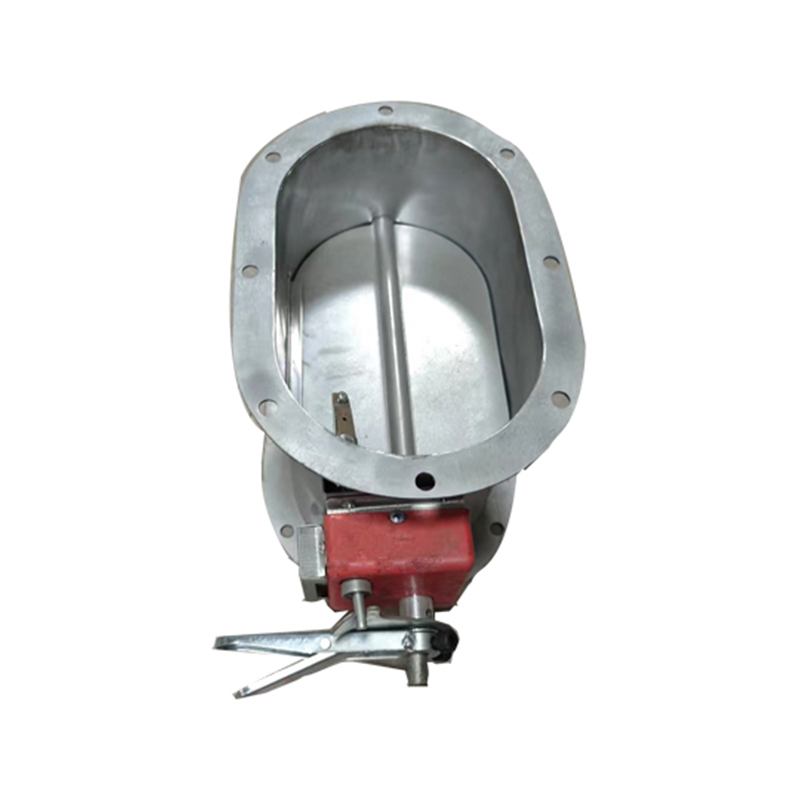How to improve air circulation efficiency through spiral duct design?
Release Time : 2025-05-21
Improving air circulation efficiency is one of the core goals in ventilation system design, and spiral duct has shown significant advantages in this regard with its unique structural characteristics and advanced manufacturing process. Through careful design and reasonable layout, spiral duct can effectively optimize airflow distribution, reduce energy loss, and ensure the efficient operation of the entire system.
First of all, the spiral structure of spiral duct itself is an important design advantage. This design not only enhances the mechanical strength of the duct and reduces the possibility of deformation, but also has a positive impact on the airflow. The spiral pattern plays a guiding role to a certain extent, making the airflow smoother and reducing the probability of turbulence. In contrast, traditional rectangular or circular ducts are more likely to produce local vortices due to the lack of such guiding structures, resulting in increased pressure loss and noise. Therefore, when planning a ventilation system, giving priority to spiral duct can fundamentally improve the airflow conditions and improve the overall circulation efficiency.
Secondly, choosing the right pipe diameter is crucial to improving air circulation efficiency. Spiral duct has a variety of specifications to choose from, and the flexible adjustment of the size according to actual needs can better adapt to different ventilation needs. Although a larger pipe diameter can provide a larger flow rate, it also increases the cost and installation difficulty; on the contrary, a too small pipe diameter may lead to increased resistance and affect the air supply effect. The ideal solution is to select a spiral duct of moderate size as much as possible while meeting the flow requirements, which can not only ensure sufficient ventilation but also avoid unnecessary energy consumption. In addition, the reasonable design of elbows and reducers is also an important part that cannot be ignored. Using smooth transition elbows instead of right-angle turns at corners can significantly reduce air flow resistance and further optimize flow performance.
Furthermore, paying attention to sealing is also one of the key factors in improving air circulation efficiency. Good sealing measures can not only prevent air leakage, but also maintain stable internal pressure to ensure that airflow is transmitted along the expected path. Spiral ducts are usually assembled with high-quality connectors and sealing materials, such as rubber gaskets, flange joints, etc. These accessories can form a tight fit at the interface, effectively preventing outside air from invading or internal gas leakage. At the same time, strictly following the operating specifications during the installation process to ensure that each joint is in the best sealing state is crucial to maintaining the long-term stable operation of the system.
In addition, simulation analysis using modern computational fluid dynamics (CFD) tools is also an effective means to optimize the design of spiral ducts. By building a virtual model and inputting relevant parameters, engineers can visually observe the movement of airflow in the duct on the computer and identify possible bottlenecks or high-resistance areas. Based on these analysis results, the pipeline layout is adjusted, the local shape is changed, or auxiliary devices are added to achieve better airflow organization. This method can not only save a lot of experimental time and cost, but also provide a scientific basis for complex projects to ensure the feasibility and reliability of the design scheme.
It is worth noting that in addition to the above technical considerations, daily maintenance work also has an important impact on air circulation efficiency. Regularly checking the status of the spiral duct, cleaning dust and debris in time, and keeping the inner wall smooth and clean will help maintain the original ventilation performance. Over time, if too much dirt accumulates, it will increase friction resistance, reduce airflow speed, and thus weaken the efficiency of the entire system. Therefore, formulating a reasonable maintenance plan and strictly implementing it are necessary conditions to ensure the continuous and efficient operation of the spiral duct.
Finally, considering the specific needs of different application scenarios, customized design ideas are particularly critical. For example, in places such as hospitals and laboratories that require high air quality, spiral ducts with high-efficiency filters can be used to purify the air entering the room; in industrial plants, special dust removal equipment may be required to work with spiral ducts to remove harmful particles. In short, only by tailoring the most suitable ventilation solution for specific environmental characteristics can the maximum potential of spiral ducts be truly realized and excellent air circulation efficiency be achieved.
In summary, improving air circulation efficiency through spiral duct design is a comprehensive topic, involving multiple links such as structural selection, size matching, sealing treatment, and post-management. Only by comprehensively considering these factors, adopting scientific and reasonable design strategies, and implementing them in combination with advanced technical means can an efficient and reliable ventilation system be built to provide users with a comfortable and healthy indoor environment. In this process, constantly exploring the application prospects of new materials and new technologies, and continuously improving design concepts and methods will also open up new possibilities for future development.
First of all, the spiral structure of spiral duct itself is an important design advantage. This design not only enhances the mechanical strength of the duct and reduces the possibility of deformation, but also has a positive impact on the airflow. The spiral pattern plays a guiding role to a certain extent, making the airflow smoother and reducing the probability of turbulence. In contrast, traditional rectangular or circular ducts are more likely to produce local vortices due to the lack of such guiding structures, resulting in increased pressure loss and noise. Therefore, when planning a ventilation system, giving priority to spiral duct can fundamentally improve the airflow conditions and improve the overall circulation efficiency.
Secondly, choosing the right pipe diameter is crucial to improving air circulation efficiency. Spiral duct has a variety of specifications to choose from, and the flexible adjustment of the size according to actual needs can better adapt to different ventilation needs. Although a larger pipe diameter can provide a larger flow rate, it also increases the cost and installation difficulty; on the contrary, a too small pipe diameter may lead to increased resistance and affect the air supply effect. The ideal solution is to select a spiral duct of moderate size as much as possible while meeting the flow requirements, which can not only ensure sufficient ventilation but also avoid unnecessary energy consumption. In addition, the reasonable design of elbows and reducers is also an important part that cannot be ignored. Using smooth transition elbows instead of right-angle turns at corners can significantly reduce air flow resistance and further optimize flow performance.
Furthermore, paying attention to sealing is also one of the key factors in improving air circulation efficiency. Good sealing measures can not only prevent air leakage, but also maintain stable internal pressure to ensure that airflow is transmitted along the expected path. Spiral ducts are usually assembled with high-quality connectors and sealing materials, such as rubber gaskets, flange joints, etc. These accessories can form a tight fit at the interface, effectively preventing outside air from invading or internal gas leakage. At the same time, strictly following the operating specifications during the installation process to ensure that each joint is in the best sealing state is crucial to maintaining the long-term stable operation of the system.
In addition, simulation analysis using modern computational fluid dynamics (CFD) tools is also an effective means to optimize the design of spiral ducts. By building a virtual model and inputting relevant parameters, engineers can visually observe the movement of airflow in the duct on the computer and identify possible bottlenecks or high-resistance areas. Based on these analysis results, the pipeline layout is adjusted, the local shape is changed, or auxiliary devices are added to achieve better airflow organization. This method can not only save a lot of experimental time and cost, but also provide a scientific basis for complex projects to ensure the feasibility and reliability of the design scheme.
It is worth noting that in addition to the above technical considerations, daily maintenance work also has an important impact on air circulation efficiency. Regularly checking the status of the spiral duct, cleaning dust and debris in time, and keeping the inner wall smooth and clean will help maintain the original ventilation performance. Over time, if too much dirt accumulates, it will increase friction resistance, reduce airflow speed, and thus weaken the efficiency of the entire system. Therefore, formulating a reasonable maintenance plan and strictly implementing it are necessary conditions to ensure the continuous and efficient operation of the spiral duct.
Finally, considering the specific needs of different application scenarios, customized design ideas are particularly critical. For example, in places such as hospitals and laboratories that require high air quality, spiral ducts with high-efficiency filters can be used to purify the air entering the room; in industrial plants, special dust removal equipment may be required to work with spiral ducts to remove harmful particles. In short, only by tailoring the most suitable ventilation solution for specific environmental characteristics can the maximum potential of spiral ducts be truly realized and excellent air circulation efficiency be achieved.
In summary, improving air circulation efficiency through spiral duct design is a comprehensive topic, involving multiple links such as structural selection, size matching, sealing treatment, and post-management. Only by comprehensively considering these factors, adopting scientific and reasonable design strategies, and implementing them in combination with advanced technical means can an efficient and reliable ventilation system be built to provide users with a comfortable and healthy indoor environment. In this process, constantly exploring the application prospects of new materials and new technologies, and continuously improving design concepts and methods will also open up new possibilities for future development.







